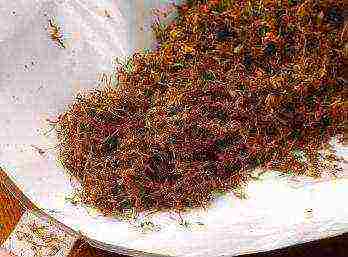Content
- 1 Which one to choose?
- 2 What pumpkin to choose for summer residents of Siberia and the Urals
- 3 Bush pumpkin varieties: Smile
- 4 Features of pumpkin care Smile
- 5 Acorn pumpkins
- 6 How to care for Acorn pumpkin
- 7 Lel variety
- 8 Variety care
- 9 Pumpkin amazon
- 10 Features of variety care
- 11 Gribovskaya bush 189
- 12 Care of Gribovskaya
- 13 Honey beauty
- 14 Care features
- 15 Variety Healing
- 16 Features of cultivation
- 17 Pumpkin variety Shrub orange
- 18 Landing features
- 19 Instead of a conclusion
- 20 Siberia and the Urals
- 21 Freckle
- 22 Russian woman
- 23 Moscow region and the Middle Strip
- 24 Northwest
- 25 Features of bush pumpkin and its benefits
- 26 Review and characteristics of the most popular varieties of bush pumpkin
- 27 Features of a bush variety
- 28 Bush pumpkin varieties
- 29 Pros and cons
- 30 Video "Growing and pinching a pumpkin"
People have been growing pumpkins for about 5 thousand years. A vegetable is not only unpretentious to care for, but also very tasty and healthy. In summer cottages, both a weaving pumpkin and a bush pumpkin can be grown. The latter variety is especially popular with summer residents. Further in the article, we will figure out what a bush pumpkin is. Varieties, photos, descriptions - all this can be found in the review.
Which one to choose?
The fruits of a bush pumpkin are formed at the base of the stem. They are usually not too large in size. Another feature of the varieties of this variety is that their fruits ripen quite early. You can usually harvest such a pumpkin as early as 80-110 days after planting. Late-ripening bush varieties practically do not exist today. The stems of the pumpkin of this variety are erect. Therefore, moisture is very well preserved under them.
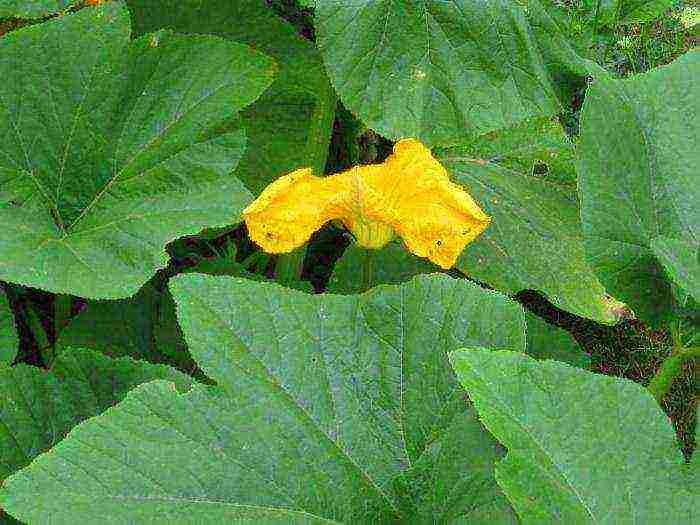
Of the early, the most popular among summer residents are the following varieties of bush pumpkin:
-
Amazon.
-
Smile.
-
Acorn.
-
Lel.
-
Gribovskaya bush 189.
The fruits of these varieties ripen on the 80-90th day after planting. Of the mid-season, most often summer residents grow:
-
Honey beauty.
-
Therapeutic.
-
Shrub orange.
These varieties of bush pumpkin are valued by gardeners, among other things, because they can be harvested already 90-110 days after planting.
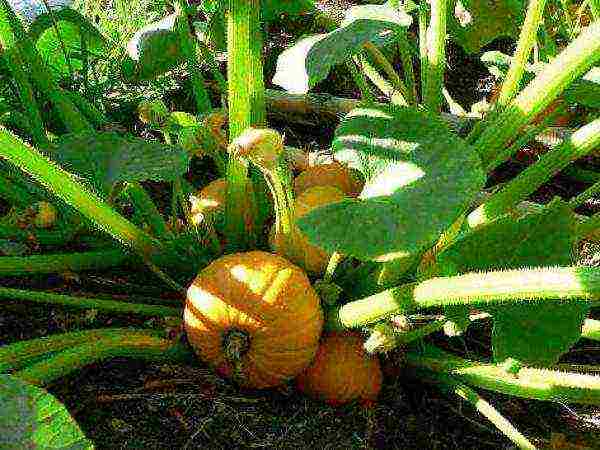
What pumpkin to choose for summer residents of Siberia and the Urals
Climbing gourds can produce large yields. But such varieties are quite difficult to care for. Owners of suburban areas, for example, have to pinch them, remove excess ovaries. In addition, climbing pumpkins are suitable mainly only for very large areas. That is why many summer residents prefer the best varieties of bush. Pumpkins for open ground of this group practically do not take up space on the site. You also need to pinch them. However, this procedure is much easier in this case.
In general, this vegetable is quite thermophilic. The varieties presented in the lists above are appreciated by summer residents not only for good yields and excellent fruit taste, but also for their resistance to cold. These are actually very popular bush pumpkins. Varieties for Siberia and the Urals (with the exception of the Amazon and Honey Beauty) are almost as good as for the south of Russia. Excellent yields can be obtained from them even in a harsh, changeable climate.
Bush pumpkin varieties: Smile
The fruits of this pumpkin are appreciated by summer residents primarily for their high taste.The Smile pumpkin was bred not so long ago - about 15 years ago, by specialists of the State Scientific Institution VNIISOOK.
The bark of this variety is not too thick. Smile pumpkin colors are bright orange. Subtle white stripes can be seen on the bark of the fruit. The pulp of this pumpkin variety is orange, dense. It tastes sweet. The aroma of the Smile pulp is not too pronounced, melon. The fruits of the variety ripen very early - about three months after planting.
The bush itself is compact, not too tall. The leaves of this variety are rather large, light green. Each Smile bush produces about six thick shoots about 1 meter long.
Features of pumpkin care Smile
It is not at all difficult to grow a good harvest of this variety in a summer cottage. Planting a pumpkin Smile is recommended in a well-sunlit place. The seeds of this variety are usually buried in the ground by 5-7 cm. The advantages of this pumpkin, among other things, include cold resistance. You can plant it in open ground at the end of May. The standard arrangement of plants of this variety in the beds is 75x75 cm.
Water the Smile pumpkin, like most other varieties, as the soil dries up. Fertilize it in the summer, usually with nettle infusion.
Acorn pumpkins
This interesting variety was bred quite recently. For the very small size of the fruit, many summer residents call it "acorn". On sale today there are both climbing and bush varieties of this variety. The skin color of Acorn pumpkin varies. Usually, in summer cottages, you can see dark or light green pumpkins of this variety. But sometimes there are also white varieties.
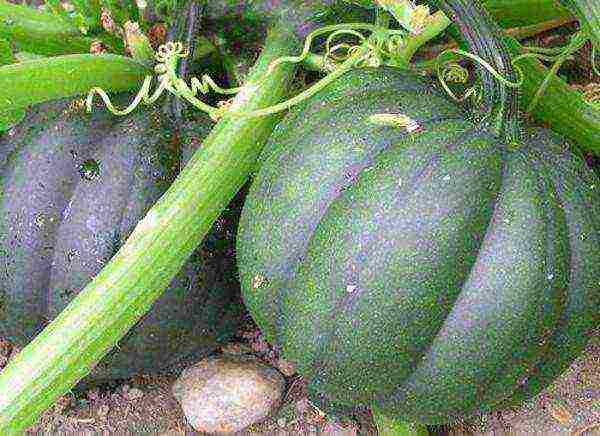
The flesh of this pumpkin is very sweet, juicy and tender, with a creamy flavor. It has a yellow-orange color. The maximum weight of Acorn fruit is 1.5 kg. They ripen about 85 days after planting.
How to care for Acorn pumpkin
This pumpkin is usually planted according to the scheme 70x70 cm. Fertilizers under it are most often applied only when sowing. In Central Russia, Acorn is planted in May-June. In order to protect the sprouts from frost, they should be covered with a film at first. It is advisable to water this pumpkin only with warm water (not lower than +20 C).
Lel variety
This is a very early bush pumpkin. Varieties (there are good reviews about them also for this reason) of this group usually bear fruit by mid-summer. Lel pumpkin can be harvested 90 days after planting. The shape of the fruits of this variety is medium flattened. Ribs on Lel pumpkins are noticeable only at the very base. The color of the peel of this variety is yellow-orange with light brown stripes. The weight of Lel pumpkin can reach 3-3.5 kg.
Variety care
This pumpkin is mainly grown only by large enterprises of the agro-industrial complex. The pulp of the fruit is not very tasty. The main value of this variety is its seeds. Pumpkin seed oil, which is very often available in stores, is made with their use.
Growing this variety is relatively easy. Bad weather conditions do not have too strong a negative effect on him. Pumpkin Lel is resistant to diseases. Powdery mildew, anthracnose and peronosporosis, these plants, for example, almost never get sick.
Pumpkin amazon
The undoubted advantage of this variety is the compactness of the bush. The Amazon pumpkin belongs to the mid-season group. You can harvest from the bushes of this variety on the 100-110th day after planting. The fruit of the Amazon is flat and has a dark orange peel with white stripes. They look very neat. The weight of this variety is usually 1-2 kg.
The flesh of the Amazon pumpkin is bright orange sweet, crunchy. The advantages of the variety, among other things, include the ability of the fruit to be stored for a long time, the increased content of carotene in them and their transportability. The bushes of the Amazon pumpkin are small, the stems are thick, and the leaves are dark green in color.
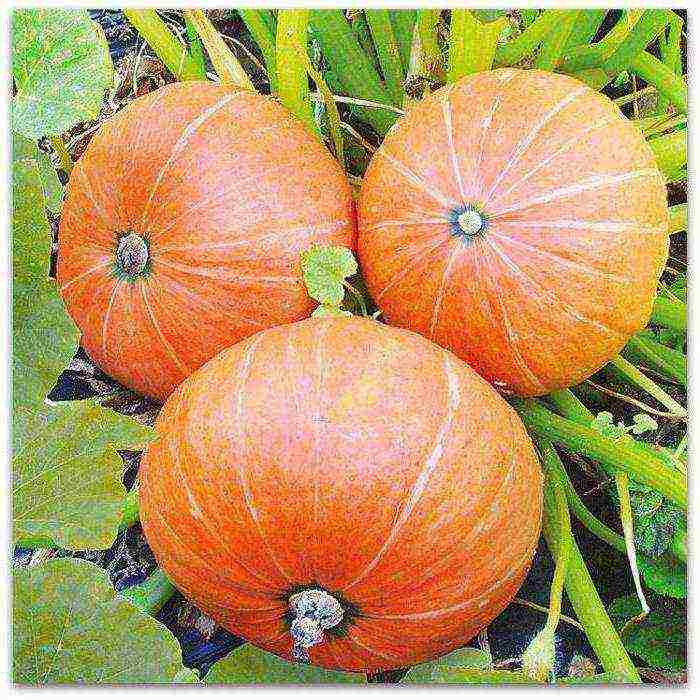
Features of variety care
The Amazon pumpkin does not belong to the group of cold-resistant pumpkins. Therefore, it is usually grown in open ground only in Ukraine, Belarus and southern Russia. Seeds of this variety are planted in these regions in April-May. The recommended layout of Amazon plants in the garden is 150x150 cm.
Gribovskaya bush 189
This oldest variety is known to many Russian summer residents. Many gardeners are interested in what varieties of bush pumpkin are suitable for the Urals. Summer residents of this region should definitely pay attention to Gribovskaya bush 189. This variety is very unpretentious in terms of weather conditions.
The fruits of the Gribovskaya bush pumpkin are large - they can reach a weight of 2-2.5 kg. In some cases, fruits weighing up to 5 kg grow on the bushes. The shape of the pumpkin of this variety is obovate, oblong. The color of the fruits of the Gribovskaya bush is dark green. As they mature, the color of their bark changes to a light orange.
The pulp of the fruits of this variety is very dense, orange, sweet. This pumpkin is harvested already on the 80th day after planting. Gribovskaya fruits can be used to prepare delicious dishes. Many summer residents believe that this variety has the most delicious pulp.
Care of Gribovskaya
The best bush pumpkin varieties are usually cold-resistant. Gribovskaya 189 belongs to the group of just such varieties, as already mentioned. This variety can be grown, including in the Moscow region, in the Urals and in Siberia. Many summer residents also consider the advantages of Gribovskaya bush 189 that this pumpkin is very resistant to all sorts of diseases. It is supposed to plant this variety in open ground in central Russia in May-June. The recommended layout for it is 60x60 cm.
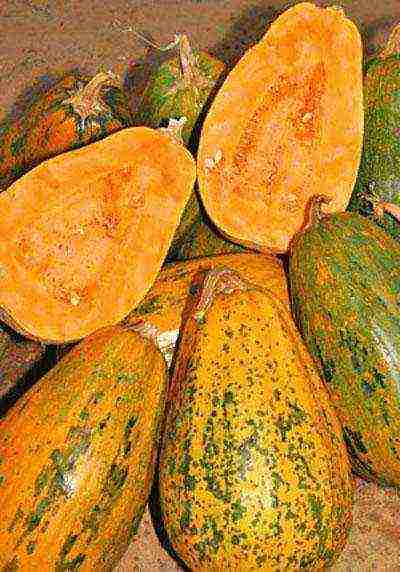
Honey beauty
It is also a very popular bush pumpkin. Varieties (photos on the page confirm this) of this group usually have rather neat fruits. This applies to the Honey Beauty in full measure. The advantages of the fruits of this variety also include their excellent taste.
The Honey Beauty pumpkin ripens approximately 90-100 days after planting. They have a rounded shape with clearly defined ribs. The color of the peel of this variety is orange. Actually, the bark itself of the Honey Beauty is very thin. The pulp of the fruit is juicy, sweet, crunchy and aromatic. The weight of pumpkins of this variety can reach 4-6 kg.
Care features
The variety Honey beauty does not differ in frost resistance. It is suitable for growing mainly in the Krasnodar Territory, Stavropol Territory, Ukraine, Moldova. It is recommended to plant it in open ground in April-May. The seeds of the Honey Beauty are deepened, depending on the type of soil, by 2-5 cm.
In care, this variety is unpretentious, but requires periodic feeding. For the first time, fertilizers are applied under the plants at the beginning of flowering. In this case, usually simple slurry is used. The second feeding is done after 10 days. Nitrogen fertilizers or humus are applied to the beds. In the future, pumpkins are fed at intervals of 7-10 days. During the ovary and ripening of fruits, mainly complex mineral compositions that do not contain nitrogen are used.
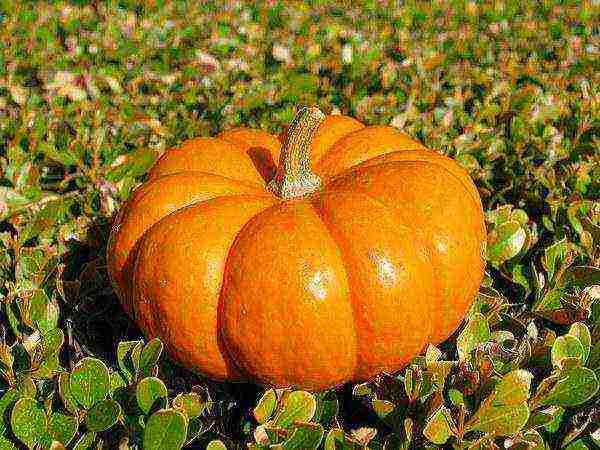
Variety Healing
The main advantage of this large-fruited pumpkin is the long shelf life of the fruit. In a cool place, they can lie until May. The weight of the fruits of this variety reaches 3-5 kg. Their peel has a light gray color. In addition to the shade, this pumpkin can be distinguished from other varieties by the characteristic intermittent stripes on the fruit. The pulp of the Healing pumpkin is tasty, light orange, crispy and sweet. Many summer residents also refer to the advantages of this variety as the increased content of carotene in the pulp. Pumpkins ripen on the 100-105th day after planting.
Features of cultivation
In terms of frost resistance, the bush pumpkin varieties Smile and Gribovskaya Healing are slightly superior. This pumpkin is grown most often in the south.However, with proper care, good yields of the Healing variety can be obtained in central Russia, and in the Urals, and even in Siberia. To do this, you just need to cover the seedlings with foil in the spring.
It is recommended to plant this pumpkin according to the scheme 80x80 cm. It is advisable to do this in May-June. Its seeds are buried in the ground by 4-6 cm. Care for this variety is standard. There are no special recommendations for him.
Pumpkin variety Shrub orange
This variety, like the Medicinal one, belongs to the group of large-fruited. Fruit weight of Shrub orange can reach up to 5 kg. Actually, the plant itself is compact at the same time.
Despite the fact that this variety belongs to the group of bush, in the second half of the season it can form not too long lashes. The peel color of the fruit of this pumpkin is very bright, orange. They have an oval shape, slightly flattened. The flesh of Kustovaya orange is yellow, sweet. Many summer residents refer to the advantages of the variety, including the keeping quality of its fruits.
Landing features
The advantage of the orange bush pumpkin is considered, first of all, that it can be cultivated, including in noisy regions. This variety is absolutely insensitive to a lack of moisture. Also Shrub orange tolerates all kinds of unfavorable weather conditions very well. This pumpkin is planted according to the standard scheme 60x60 cm or 70x70 cm.

Instead of a conclusion
Thus, we found out what are the most popular garden crops, bush pumpkin, varieties. Photos of the impressive fruits of this group are presented on the page. Growing the same beautiful neat pumpkins on your site is within the power of any summer resident. The advantages of bush varieties include their unpretentiousness. However, you should certainly take care of this culture. In this case, she will delight the owners of the site with high yields and excellent taste of the fruits themselves.
Pumpkin is rightfully considered one of the most delicious and healthy vegetable crops. Moreover, it tastes equally good both fresh and boiled, fried and baked. The composition of the pumpkin contains a large amount of substances and vitamins necessary for the human body, so it should grow on the site of every gardener. They love pumpkin in different regions of Russia, and this gives a reason to take into account the climatic features of each area. The volume of the crop that the farmer can count on depends on the growing conditions.
The best varieties of pumpkin for open ground
Siberia and the Urals
Siberia is a very special territory characterized by extremely long frosts. Frosts in this area continue until the first month of summer. This important factor must be taken into account when choosing a vegetable variety. The main qualities of the planting material for Siberia are frost resistance. Several varieties of pumpkin are ideal for these parameters.
Smile
Pumpkin variety Smile
The peculiarity of Smile is that this variety is not only cold-resistant, but also high-yielding. In addition, it is characterized by a short ripening period - after the sprouting of the first shoots, it takes only three months until the pumpkin can be eaten. At the exit, the farmer receives medium-sized (from half a kilogram to two kilograms) orange fruits with dense and sweet pulp. Pumpkin Smile can be stored until January - however, it is unlikely that it will "live" right up to winter - it is too tasty.
Pumpkin Seeds Smile
Initially, the Smile variety was bred as an ornamental variety, and it corresponds to its purpose. On the site, the plant looks spectacular - large leaves with an outstanding pattern, large bright flowers and an intoxicating aroma. And the fruits are a real work of art. A lot of them immediately appear in the garden - up to fifteen pieces. With proper care, the Smile variety gives up to three kilograms of fruit from one bush.
Pumpkin Smile - early ripening variety
Freckle
Pumpkin variety "Freckle" refers to early ripe pumpkins
The "Vesnushka" variety is also well suited for Siberia and the Urals. Three-kilogram fruits ripen quite quickly and differ in their characteristic appearance - the green peel is "diluted" with light spots. The pumpkin flesh is soft, juicy, tender and has a delicate pear flavor. Among other advantages of this variety, there is a high yield, subject to abundant watering and long-term storage at room temperature.
Pumpkin variety "Freckle"
Russian woman
Pumpkin Rossiyanka also belongs to cold-resistant, as well as early-maturing varieties. The ripening period is about three months. The fruits of the Russian woman are quite large - from two to four kilograms. At the same time, up to twenty kilograms of fruit are obtained from one bush with proper care - impressive results. The pumpkin grows bright and tasty - delicate sweet pulp with a melon aroma.
Pumpkin "Rossiyanka" - early ripe pumpkin, climbing, lying, tasty, versatile
Farmers advise sowing the crop in April so that it can be planted in the ground in May-June. In this case, you can fertilize the soil with organic fertilizers, then the harvest will be richer. If you want to store the pumpkin for a long time, then provide suitable conditions for this - dry air and a room that is well ventilated.
Pumpkin seeds "Rossiyanka"
Moscow region and the Middle Strip
For these areas, there are also pumpkin varieties that thrive best in these climatic conditions.
Therapeutic
Healing pumpkin. Description of the variety
A characteristic feature of this pumpkin in its shape is a little flattened, it is always easily recognizable among other fruits. Farmers highly value the Healing pumpkin for its excellent taste, rich smell, bright color, as well as for its practical quality - early ripening (about three months). Outwardly, the pumpkin is easy to recognize not only by its specific shape, but also by the gray-green color of the peel with a unique pattern.
Healing
Another excellent early-ripening variety is Healing pumpkin, which, like other "brethren", has excellent taste. Oval orange fruits without a pattern have a juicy flesh. The mass of one fruit is from 2.5 to 3 kilograms. The pumpkin can be easily stored without loss of taste for up to 6 months.
Healing pumpkin
If you want to harvest in August, then this pumpkin variety should be planted in June. It is important to choose a well-drained soil and preferably a sunny location. This pumpkin loves water, so don't skimp on watering. Experts advise to mulch the holes with peat, which will prevent rapid evaporation of water.
Sweet pie
Pumpkin "Sweet Pie"
A variety with a tasty name refers to early ripening, that is, it will take about 3 months for fruits, the average weight of which is from 2 to 3 kilograms, to ripen. Among the features of pumpkin are crispy and very tasty pulp, which is excellent for preservation. Farmers love this variety for its high and stable yield, but for this you need to provide it with proper care: regular watering, feeding, loosening and weeding. It is ideal to sow a sweet cake in such conditions when the soil reaches a temperature of 12 degrees.
Candied fruit
Candied fruit is a variety that is characterized by high yields and quick ripening (from 112 to 118 days). The fruits will be quite large - about 2 kilograms, so you need to sow seeds with this calculation. The flesh of the candied pumpkin variety is very tasty - juicy, crunchy and aromatic.
Large-fruited pumpkin "Candied"
Farmers recommend planting candied fruits on sandy loam and easily, loamy soil, since it is on this soil that the variety gives the richest harvest. After planting, you need to wait for the first shoots and remove weak plants, and the rest should be watered abundantly, weeded, pinched and fed.
Premiere
If you are looking for a versatile pumpkin, then Premiere is the perfect option.Add to this the early maturity of the variety and the high yield, and you will no longer look for other pumpkin varieties. As a result, farmers receive large, smooth fruits with a high content of sugar, carotene and dry matter.
Pumpkin Premiere
It is necessary to sow seeds at a time when the threat of frost has completely passed, that is, not earlier than the end of May - beginning of June. In order to end up with large fruits and ripen quickly, you need to leave from 2 to 4 fruits on one bush. The premiere is kept well enough.
Gribovskaya winter
Pumpkin "Gribovskaya" winter large-fruited
Unlike other varieties described above, Gribovskaya Zimnaya belongs to the late-ripening varieties - the ripening period for fruits is from 128 to 140 days. However, at the same time, the plant is quite fruitful. The mass of one pumpkin is from 3 to 7 kg. Other advantages include good transportability and long-term storage.
Gribovskaya bush 189
Gribovskaya bush 189
This pumpkin variety is known for its unusual egg-shaped fruit. Ripe pumpkin has a light orange hue, ornately decorated with greenish patterns. The fruit tastes very tasty - sweet and juicy, as well as large enough - about 5 kilograms. They are characterized by high transportability and good keeping quality.
Experienced farmers assure that you need to sow the seeds of the variety in late May - early June.
Pumpkin Gribovskaya Bush 189
Dachnaya
The dacha variety is rightfully considered one of the earliest ripening varieties - already 70 days after germination there will be the first harvest. The fruits are oval or ovoid, and in color they are yellow and only the stripes have a dark green tint. This pumpkin is very sweet and juicy. The average weight of one fruit is about 3 kg.
Pumpkin Country
Among the main advantages of the variety, farmers note its high yield, early maturity, as well as resistance to cold weather. To get a good result, you need to sow the pumpkin only when the ground warms up to at least 10 degrees. It is very important to water, weed and huddle the plant in a timely manner.
Northwest
Bush orange
The Kustovaya Orange variety has a very modest size. This is an early maturing plant that bears bright large fruits weighing about 4 kilograms. The pumpkin pulp is very tasty: juicy and sweet, and also has a high carotene content. The pumpkin bark is also delicious - sweet and crunchy.
Orange bush pumpkin
Among the advantages of the variety, one can note its early maturity and versatility, since the Bush orange pumpkin is used both fresh and baked, stewed and fried.
Trojand
The Troyanda variety is excellent for growing in the middle lane - in such climatic conditions, the plant gives a fairly rich harvest. The fruits on the bushes are large (up to 7 kilograms) and tasty. The most important advantage of the Troyanda variety is its disease resistance. Plus, the pumpkin can be stored for a long time.
Chit
Pumpkin variety Crumb
This variety was bred a long time ago - at the beginning of the 21st century. This is one of the few varieties that is completely "understandable" for farmers, since no unpleasant surprises can be expected from it. It is reliably known that the size of the fruits will be very modest and hardly exceed three kilograms in weight.
Outwardly, it is a rounded flat pumpkin of light gray or almost white color. It is very tasty, juicy, soft, bright yellow. Differs in a high content of sugars and solids.
Acorn
This variety has another name, which is more common among the people - "acorn". The plant deserved it due to the external similarity of the fruits to acorns, of course, in different proportions. The pumpkin pulp has an orange-yellow pulp and a very pleasant sweet taste.
Acorn
As for the color of the peel, the options can be different: from green to orange. Sometimes these shades are bizarrely combined with each other.
Pumpkin Acorn in the garden - photo
Obviously, there is a wide variety of pumpkin varieties that are suitable for outdoor use. Study the features of the local climate and, depending on this criterion, choose the plant that is guaranteed to take root in your area.
Video - The best pumpkin varieties for open ground
Many gardeners, who have gained experience in growing pumpkins, do not deny themselves the pleasure of planting several types, varieties of "sunny" vegetables in the future. Pumpkin is an unpretentious, fruitful crop, the disadvantage of which some summer residents consider the ability to occupy a large area during the growth period. So think only those who do not know about the existence of a subspecies - bush pumpkin, which is a plant with small in length, compactly growing lashes.
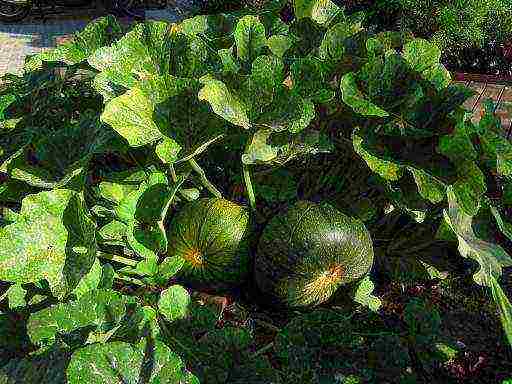
Features of bush pumpkin and its benefits
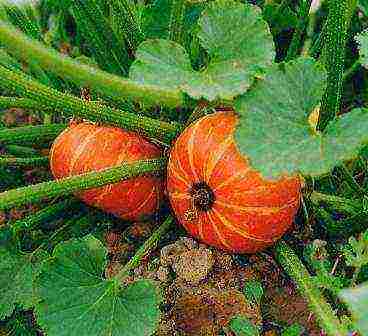 For planting on a small backyard, bush pumpkin of the best varieties is ideal. She does not need a lot of space in the garden. A gardener who has planted a culture does not need to engage in the formation of plants, cutting off excess lashes, shortening shoots. In a bush pumpkin, fruits are formed at the base. Its shoots and stem are erect, which ensures better moisture retention under the bush, and has a positive effect on yield.
For planting on a small backyard, bush pumpkin of the best varieties is ideal. She does not need a lot of space in the garden. A gardener who has planted a culture does not need to engage in the formation of plants, cutting off excess lashes, shortening shoots. In a bush pumpkin, fruits are formed at the base. Its shoots and stem are erect, which ensures better moisture retention under the bush, and has a positive effect on yield.
The main advantage of bush pumpkin is early maturity, which favorably distinguishes it from the climbing "relative". For example, Gribovskaya pumpkin ripens in 70 days. For the full ripening of the fruits of a bush plant, on average, 85 - 100 days are required. The beautiful fruits of this "sunny vegetable" subspecies are characterized by excellent taste. The flesh of most varieties is bright orange, juicy, extremely tender, sweet, rich in carotene.
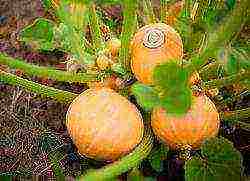 The size of the fruits of the culture is relatively small. The mass of vegetables is generally in the range of 0.6 - 3 kg. From one bush, you can get a crop in the amount of 4 - 15 pieces. Such fruits are called portioned. Having plucked from the garden, it is very convenient to immediately use them for cooking various dishes, use them raw without fear of leaving unused pieces. Nevertheless, the weight of the fruits of some varieties can reach 4 - 6 kg or more.
The size of the fruits of the culture is relatively small. The mass of vegetables is generally in the range of 0.6 - 3 kg. From one bush, you can get a crop in the amount of 4 - 15 pieces. Such fruits are called portioned. Having plucked from the garden, it is very convenient to immediately use them for cooking various dishes, use them raw without fear of leaving unused pieces. Nevertheless, the weight of the fruits of some varieties can reach 4 - 6 kg or more.
As mentioned above, a bush pumpkin does not need to allocate a large garden bed. The optimal crop planting scheme is considered: 60 x 60 or 70 x 70 cm.
Bush pumpkin varieties for the Moscow region demonstrate resistance to cold, undemanding care, cultivation takes place without problems.
Review and characteristics of the most popular varieties of bush pumpkin
Modern breeders have managed to bring out many wonderful varieties of this pumpkin variety. Below are the most successful varieties of bush pumpkin that are popular with gardeners - our compatriots.
Pumpkin variety Smile
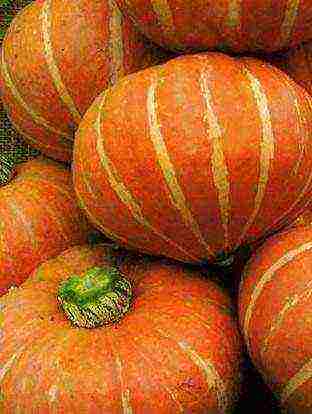 Bush pumpkin Smile is liked by many summer residents because of its early maturity. The ripening of the fruits of the culture occurs in the shortest possible time (85 days). Short shoots (up to 6 pcs.) Are formed on the plant. Giving feedback on the Smile pumpkin, gardeners note the culture's ability to endure spring cold snaps.
Bush pumpkin Smile is liked by many summer residents because of its early maturity. The ripening of the fruits of the culture occurs in the shortest possible time (85 days). Short shoots (up to 6 pcs.) Are formed on the plant. Giving feedback on the Smile pumpkin, gardeners note the culture's ability to endure spring cold snaps.
The weight of ripe fruits is 1 - 2 kg. The color of vegetables is bright orange, their shape is rounded, somewhat flattened, the surface can be smooth or slightly segmented. The sweet, crunchy fruit pulp has a rich orange color and a pleasant melon aroma. The variety is famous for its wonderful taste, dietary qualities, excellent transportability.
Pumpkin variety Healing
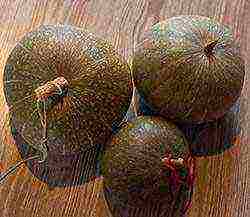 The early maturing curative pumpkin is a compact plant that is resistant to temperature fluctuations. It takes up to 105 days for the fruit to fully ripen. The fruits of the culture will delight you with good transportability, preservation for a long period (until May). The culture is grown in open field conditions.
The early maturing curative pumpkin is a compact plant that is resistant to temperature fluctuations. It takes up to 105 days for the fruit to fully ripen. The fruits of the culture will delight you with good transportability, preservation for a long period (until May). The culture is grown in open field conditions.
The pumpkin fruits of the Lechebnaya variety have a rounded-flattened shape, a weakly segmented surface, weighing 3 - 5.5 kg. The color of the thin, leathery peel is light gray with spectacular intermittent small stripes. Juicy, thick, crunchy pulp has a light orange color, sweet taste.
Pumpkin variety Pearl
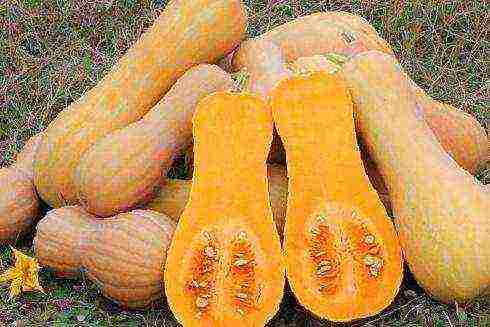 Delicious pumpkin Pearl feels great outdoors in our latitudes. For the full ripening of the fruits of the culture, it takes 100 - 110 days. The yield of the variety is quite solid: 15 kg / sq. Gardeners who publish reviews of the Pearl pumpkin note that the seeds are very small.
Delicious pumpkin Pearl feels great outdoors in our latitudes. For the full ripening of the fruits of the culture, it takes 100 - 110 days. The yield of the variety is quite solid: 15 kg / sq. Gardeners who publish reviews of the Pearl pumpkin note that the seeds are very small.
Varietal fruits have a recognizable elongated-cylindrical shape, yellowish-orange color, smooth surface, weigh up to 7.5 kg. The thick flesh of the vegetable has a reddish-orange color. The palatability of the pulp is excellent: it is tender, sweet, juicy. Fruits are easily transported over long distances, well stored.
Pumpkin variety Bush orange
 Yielding orange bush pumpkin ripens on 95 - 105 days from the moment the sprouts hatch. The fruits of the culture are perfectly preserved in the winter. This variety is considered the pride of Russian selection. Unpretentious, compact varietal bushes can be grown in beds in regions with variable climatic conditions.
Yielding orange bush pumpkin ripens on 95 - 105 days from the moment the sprouts hatch. The fruits of the culture are perfectly preserved in the winter. This variety is considered the pride of Russian selection. Unpretentious, compact varietal bushes can be grown in beds in regions with variable climatic conditions.
The fruits of the plant are suitable for universal use, have a round or slightly cylindrical shape, weigh up to 5 kg. The pumpkin peel is thin, monochromatic, its structure is leathery. The juicy pulp has a yellow color and is characterized by a high content of carotene.
Pumpkin Variety Hundred Pound
The Mid-Late Hundred Pound Pumpkin got its name from the ripening of large fruits.
The culture demonstrates resistance to bacteriosis, powdery mildew, and rot. The fruits are endowed with a spherical shape, smooth, slightly segmented surface. The thin bark of vegetables has a yellow-orange color. The pulp has a loose structure, creamy yellow color, it is considered not very sweet. The yield indicators of the variety reach 6.3 kg / sq.
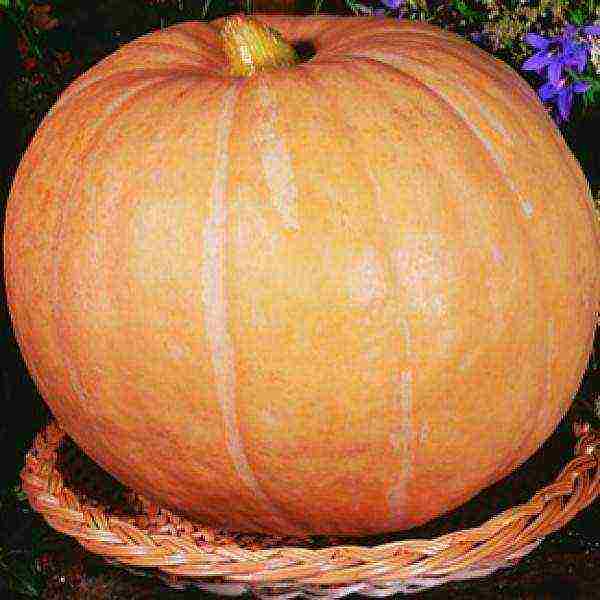
Pumpkin Hundred Pound
Pumpkin variety Amazon
The mid-early Amazon pumpkin is an extremely compact plant. The ripening of the crop can be expected in the period of 90 - 110 days from the moment of germination. Beautiful fruits of the culture have a flat shape, dark orange peel, weigh 1 - 2 kg. The color of the sweet, crunchy pulp is rich orange. The preservation, taste, and commercial qualities of vegetables are very high.
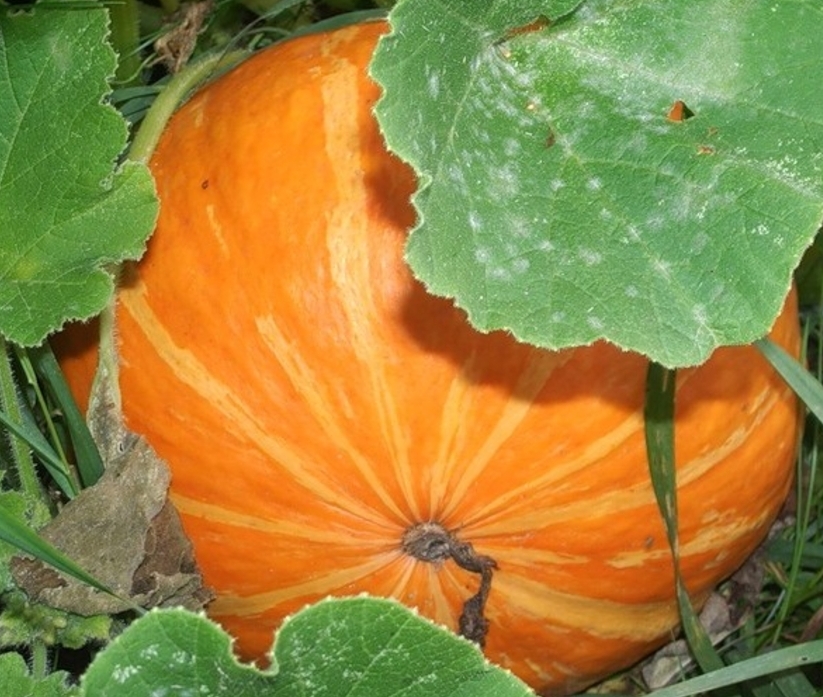
Pumpkin amazon
Pumpkin variety Rouge Wife DEtamp
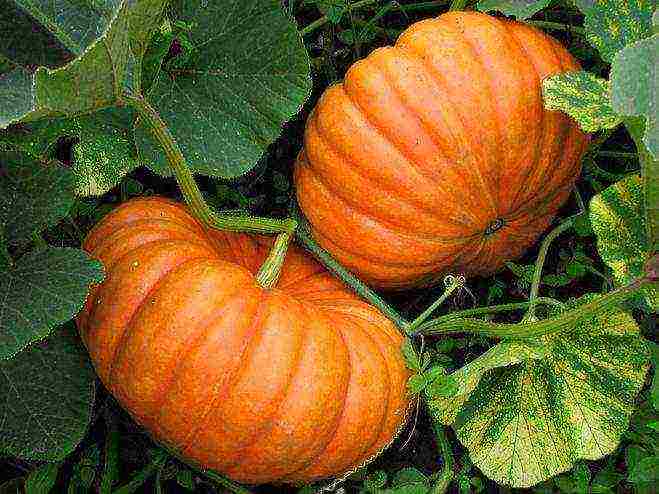 Mid-season pumpkin Rouge Wife DEtamp is chosen by gardeners because of the excellent preservation of large fruits rich in a picture, as well as in the Golden Seed variety. Excellent mashed potatoes and juices are prepared from vegetables. The variety is resistant to downy mildew, leaf mosaic, powdery mildew. The fruits of the culture are red-orange, their shape is flattened, the surface is segmented. The color of the dense pulp is orange, its taste is excellent.
Mid-season pumpkin Rouge Wife DEtamp is chosen by gardeners because of the excellent preservation of large fruits rich in a picture, as well as in the Golden Seed variety. Excellent mashed potatoes and juices are prepared from vegetables. The variety is resistant to downy mildew, leaf mosaic, powdery mildew. The fruits of the culture are red-orange, their shape is flattened, the surface is segmented. The color of the dense pulp is orange, its taste is excellent.
By giving preference to planting several varieties of bush pumpkin on the site, you can get tasty fruits of various shapes, colors, with the help of which it is possible to successfully diversify the diet of households. In addition, the bush variety of the "sunny vegetable" for Siberia is capable of giving the garden a special flavor, pleasing the eye with its beauty all season. Also read the article: Is Ornamental Gourd Good for Food?
Brought from America, this sunny miracle has become an integral part of our culinary tradition. It is consumed raw, fried, boiled, baked. Pumpkin is famous for its nutritional and dietary properties, and no gardener can resist the opportunity to grow such a beauty.
Features of a bush variety
The cultivation of this melon culture is not difficult and cost-effective.But the only problem that growers may face is the plant's tendency to trail and travel widely. But breeding technologies do not stand still and a solution to this problem has long been found - varieties of bush pumpkin have been bred.
The main advantage of this type of pumpkin over long-leaved is its early maturity. The crop is ready to be harvested within 3 months after germination. Care consists only in weeding, loosening, watering and, rarely, pinching the side lashes. It is great for small areas, because the fruits grow at the very base, unlike ordinary ones. Bushes of long-growing crops need to be formed separately: shorten the shoots, cut the lashes.
The fruits of a bush pumpkin variety reach a weight of 0.5 to 3 kg. You can get 5-15 pieces from one bush. The planting scheme of this culture has the following parameters: 60 by 60 cm or 70 by 70 cm.
Bush pumpkin varieties
Pumpkin varieties, including bush, are usually divided into early and mid-season.
The well-known bush pumpkin Gribovskaya belongs to the early ripening ones. She is undoubtedly the record holder for maturation - up to 80 days. Its fruits are elongated, with a very smooth, as if glossy, bright orange skin. Pumpkin Gribovskaya is famous for its rich yield: up to 8 kg of harvest can be harvested from a 1 m by 1 m plot. Winter hardiness and transportability are also at the highest level.
Dachnaya (early maturing variety) is known for its cold resistance. It rises on the 80th day and has ovoid yellow fruits with green blotches.
Another early maturing pumpkin is Shrub gold. It is unusual for its large, sometimes even 5-kilogram, fruits. The plant got its name for a reason, because in the sun the dazzling orange skin looks really golden. But its pulp is yellow, crunchy, but not very sweet.
Pumpkin Orange Summer is considered a super early variety. It is a hybrid with rounded reddish fruits. They are imposed on 2-3 pieces. This variety is intended for cooking, because it is insanely sweet and aromatic.
Variety Prikornevaya has few lashes, which is why it is very compact. The fruits are flattened in shape, have a fairly large seed chamber, but very juicy and bright orange pulp.
Few have heard of the early maturing bush variety Lel, because it is relatively young. Its leaves and stems are covered with thorns and thorns. Interestingly, the value of the plant lies not in the pulp, but in the seeds. They contain a huge amount of fat, which is why they are widely used in medicine.
Mid-season pumpkin varieties are no less popular. Barnaul bush ripens on the 105th day, it is stored for a very long time, without losing its taste. The roll will ripen on the 120th day from the moment of germination. The size of the bush is quite small, but the fruits can reach 8 kilograms. Crocus variety ripens on the 120th day and looks like "from the picture". The fruit is perfectly round and has a pleasant tangerine color.
Ornamental vegetables have recently become popular for the Moscow region, among them the mid-late Green Pumpkin. The fruits of this plant are dark green, turbid in shape. They are not only decorative, but also useful, because they are often recommended for dietary nutrition.
There are countless pumpkin varieties, but there are those that have been tested and recommended by experienced gardeners more than once.
Smile
This pumpkin has earned its popularity due to its early maturity. Already on the 85th day, you can harvest. Fruits are bright orange in color, smooth and segmented. Their average weight is 1–2 kg. The pulp is sweet, juicy, has a pleasant melon aroma. The advantage of Smile is that it survives spring frosts without any problems.
Therapeutic
Early maturing, temperature-resistant and compact vegetable. It takes 105 days to fully ripen from the day of germination. Fruits are roundish, but flattened, dark green in color with a gray tint, weighing up to 5 kg. They are excellently transported and stored for a long time.
Pearl
Grown outdoors for about 110 days. Competitive yield - 15 kg per square meter. It is distinguished by its elongated shape, yellow-orange color. Fruits reach 7.5 kg. The pulp is reddish, tender and sweet in taste.
Bush orange
Orange bush pumpkin ripens on the 100th day. Plant of Russian selection, picky and compact. The peel is characteristically thin, and the fruit itself is round or cylindrical.
One hundred pound
Surprisingly resistant to bacterial diseases, powdery mildew, root rot. Fruits are spherical with a segmented surface. The pulp is loose, creamy yellow, not very sweet.
Amazon
Medium early, surprisingly compact pumpkin. Fruits are flattened, dark orange in color, weighing 1–2 kg. The inside of the pumpkin is orange, very sweet.
Rouge Wife DEtamp
A mid-season variety, loved for its long-term preservation and disease resistance. Fruits are red-orange, flattened, segmented.
Pros and cons
Advantages of a bush pumpkin variety:
- convenient growing in a small area;
- early maturity;
- cold resistance;
- high portability;
- yield;
- disease resistance;
Minuses:
- often hard skin;
- not all varieties of bush pumpkin are sweet.
Video "Growing and pinching a pumpkin"
In this video, you will learn how to grow and pinch pumpkins in your area.


